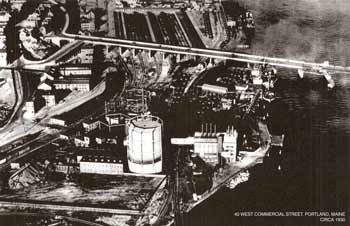A Freezer Warehouse for Portland
by Nicholas Walsh, PA

Commercial Street, Portland circa 1930. The proposed freezer warehouse would occupy the land where the round gas tank is located, lower center. The new Portland Yacht Services Building is now located in the foreground below the tank. The south Portland bridge is in the background.
The Port of Portland has been offered a generational opportunity: a modern freezer warehouse, accessible by sea, rail, air and highway, available to every food producer in the region, and built with private capital. But there’s a hitch: The proposed warehouse would be built in the Waterfront Port Development Zone, an area zoned with a maximum height of 45 feet, and the warehouse must be 68 feet tall to accommodate enough pallets to make the project economical on the limited available land.
The zone is the heart of Portland’s industrial waterfront. The container terminal is in the zone, and the zone extends to the Sprague Marine Terminal, by the Veteran’s Memorial Bridge. The area has a rich history in shipping. A gas plant once resided there, converting shiploads of coal to lamp gas, and not so long ago the massive “china clay” docks, handling kaolin for the paper mills, towered over West Commercial Street precisely where the freezer warehouse would be sited.
There are comparable buildings on Portland’s waterfront today. Sprague Energy’s white newsprint warehouses, located adjacent to the Veteran’s Memorial Bridge on what was the Merrill Marine Terminal, are 60 feet tall. The Pierce Atwood building, a former cold storage warehouse, is about 70 feet. Most of the property on the north side of Commercial Street is zoned to allow buildings up to 65 feet in height, such as the Marriott Courtyard hotel.
The warehouse would not be painted white, and it would not be a box. Rather, it would be an attractive, modestly scaled structure resembling an office building, and indeed the building would include the North American headquarters for Eimskip, the Icelandic shipping line. The warehouse is an appropriately sized project in an appropriate zone, and it’s something Maine badly needs.
The Port of Portland has always handled food. Yet for decades the Port has been without a cold store warehouse usable in conjunction with deep-water shipping. Every serious study of the Port of Portland, whether privately commissioned or government sponsored, has identified a cold store warehouse as conspicuously lacking among the Port’s assets. There are dozens of superb business opportunities that Portland has lost because the Port lacks a freezer warehouse.
The benefits of such a warehouse would extend throughout the state and region. More and more, Maine’s fishermen, farms and other food producers recognize that to compete across the world they must produce value-added food: not just fish fillets, berries or pork, but ready-to-cook portioned fish, frozen berry desserts, and gourmet sausage. While the freezer plant is under construction, sales people will fan out across Maine to show food brokers and producers how a frozen product can add to their bottom line. The freezer warehouse would be able to handle pallet loads, allowing Maine’s smaller food producers, those who could not now fill a container, inexpensive access to distant markets – including Europe and Asia. The freezer warehouse is a game-changer for Maine’s niche food producers in Greater Portland and throughout the state. The freezer warehouse is truly a project of regional significance.
There is organized opposition to the warehouse, in the form of landowners whose homes overlook the site. Many of those people assert, with justification, that they bought their homes knowing that they would overlook the industrial waterfront, but also knowing that the zoning restricted building heights to 45 feet. Changing the maximum allowable height now, they argue, would be unfair. While I see their point, that part of Portland’s waterfront is intended to be intensively developed for blue water shipping, and a maximum building height of 45 feet is simply incompatible with that use. The zoning change has the better side of the argument, in my opinion.
I don’t have a dog in this fight: I’m not hired by anyone. I do, however, believe that the 300-year history of the Port of Portland makes clear that a healthy port must be tended with care. Cargoes decline and new cargoes take their place, some moving in modern containers, some in bulk and some in break-bulk, and all by sea. A healthy port adapts to and provides accommodation for new cargoes, and even across the centuries that port continues to thrive. The freezer warehouse represents that process. If you agree, or if you think your business would benefit if pallet loads of frozen seafood could be shipped from Portland, feel free to let the City know by emailing Bill Needelman at wbn@portlandmaine.gov.
Stay out of trouble.
Nicholas Walsh is an admiralty attorney with an office in Portland, Maine. He may be reached at 207-772-2191, or nwalsh@gwi.net.
